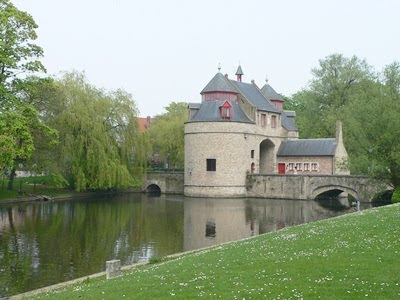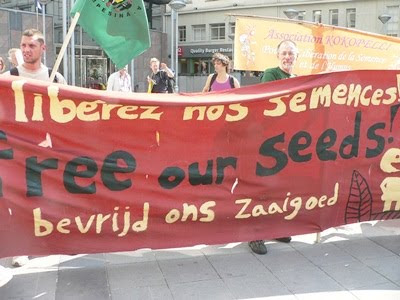
Two Seed Savers staff members and I were going to a conference in Brussels on the proposed new EU seed laws, so Bill and I took the opportunity to go over a few days early and do see some sightseeing. The weather was fine and the outdoor cafes were buzzing with residents and tourists enjoying the spring sunshine.
Of course we had to sample one of Belgium's most famous products. Here's Bill mentally preparing himself for the Five Belgian Beer Taste Test.

We chased the beer with Belgium's other famous comestible - chocolate!

Brussels is a fairly big city but very walkable. We spent a long day just walking around and saw some fancy buildings arranged around a big square.......


....pretty flower plantings and public parks.....



...the EU Parliament building (Brussels is the seat of the EU government)....

....a small castle in a park....

...giant flower pots (or else tiny people)....

...and an inexplicable sign.

Bruges, Belgium
The next day we took a day trip to Bruges, about an hour away by train. Bruges is known as 'the Venice of the north' for the canals that crisscross the historic part of the city.


Bruges is in north Belgium, and the culture and language are Dutch, whereas in Brussels the language and culture are mostly French. The buildings around the main square in Bruges have the stepped gables typical in the Netherlands.


A wide canal separates the historic center of Bruges, essentially an island, from the newer parts of the city.

And of course we had to sample the local brew!


International Seed Swap
Back to work. The first day of the conference was an international seed swap, with seed saving groups and organisations from Poland, Germany, France, Denmark, Greece the UK and the Netherlands with seeds to share with each other and with local gardeners. My colleagues Peter, Matteo and I were giving away seeds of Irish veg like Balbriggan Brussels sprouts, Gortahork cabbage and Tipperary turnip.

The EU laws governing the growing and sales of seeds are confusing and inconsistently applied by each member state (country). At Irish Seed Savers Association (ISSA), about 30% of the vegetable and grain seeds that we grow are of Irish origin and thus fall under a less regulated category known as 'conservation varieties'. It is for the research work and maintaining a seed bank of these Irish varieties that we receive funding from the Irish Department of Agriculture.
The other 70% of the seeds produced at ISSA are of non-Irish origin, but are varieties that are well adapted to our cool, maritime climate, such as tomatoes from Canada and Russia. According to current EU seed legislation,varieties that are not from the region of origin are supposed to be registered, which of course costs money. One way we've gotten around this at ISSA is by giving free seeds to people in exchange for becoming members of our organisation, but we do increasingly sell seeds to the public through shop sales and our website.
 Free seeds for all! This group brought a beautiful display, and we picked out a bunch of new varieties to try out in Ireland.
Free seeds for all! This group brought a beautiful display, and we picked out a bunch of new varieties to try out in Ireland. 
The reason no-one has been bothered by what Seed Savers does is the lack of big seed companies in Ireland. There are only two, and we are the biggest. The climate is simply too moist for large scale seed production, and many our seed crops have to be grown in plastic greenhouses to keep the seeds from sprouting or going moldy on the plants.
The big seed growers are located in hot, dry countries like France, Spain, Italy, Turkey and Germany. The French seed saving organisation Kokopelli has been fighting a lawsuit for years from a big seed company which claims that Kokopelli has an unfair market advantage because they did not register their seed varieties.

The EU is now looking to 'harmonise' the seed laws, and no one is sure which way this is going to go. They have presented five different scenarios that stakeholders can comment on, ranging from a two tier system that liberalises the laws on heritage and 'niche market' varieties, to a centralised system that requires registration by all breeders and growers.

Seed saving groups stress the importance of keeping varieties that have been adapted to local climates, as well as maintaining open-pollinated seeds. The commercial seed industry is increasingly dominated by hybrid and GM seed, which cannot be saved to sow again the following year. Only open-pollinated seeds will produce a next generation of offspring that are 'true-to-type', and keep the option for seed breeding and production open to all gardeners and farmers.
It's as if Microsoft were trying to stop people from using open-source Linux, claiming unfair competition.
Seed Sovereignty Demonstration March
The second day began with group discussion and presentations in the morning, and in the afternoon a march with approximately 500 participants to the EU headquarters of Monsanto, Bayer and the European Seed Association. 58,000 signed petitions demanding the right to traditional and heritage varieties were handed over to Members of the European Parliament.



Music for the march

Representing the American corporate interest

Monsanto headquarters. The riot police were ready but it was a completely peaceful demonstration.



Achill Island, County Mayo
Another work-related trip in April, this time to the Museum of Country Life in County Mayo to give a talk and demonstration on planting Irish potato varieties. We went a couple of days early to spend some time hiking on nearby Achill Island.

The view from our hostel window - the grass really is neon green at this time of year.

We walked to a very sad 'famine village' consisting of the ruins of over 50 cottages, with the potato ridges of the unharvested blighted potatoes still visible in the adjacent fields.


Beautiful cliffside walks to the top of Achill Island, 2,000 feet above sea level.


Numbing my tired feet in icy waters after a six hour hike.

Leaving Achill - a defensive castle.....

...and a beautiful roadside combination of wild heather and gorse.

The grounds of the Museum of Country Life

